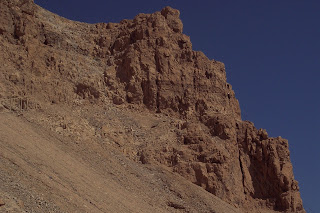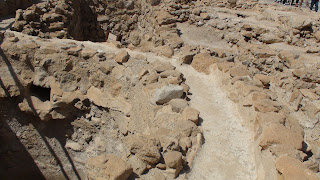We started the day with a visit to the Israel Museum. The first stop was almost like being in Legoland. We say a scaled model of Jerusalem during the Second Temple period. The model is not only to scale but is also topographically accurate and built from the same material as the actual city. The model is about 1/3 of an acre.
The Shrine of the Book was also at the museum and contained a replica of a scroll of the book of Isaiah. The construction of the shrine reflect the life of the scribes. The exhibit area is shaped like a jar in which the Dead Sea Scrolls were found. Water fountains along the top of the exhibit represent the cleansing rituals.
We visited Yad Vashem, the memorial to the Holocaust. The children's memorial was a reminder of how pervasive the persecussion was. The main part of the museum was built in a triangle to symbolize the Jews wandering without a home. Inside, there was a great deal of information about the events leading up to and during WWII. The section on people that helped protect Jews was very interesting. At the end of the museum, you exit with a view of Israel as a picture of hope.
We then headed south about six miles to Bethlehem. The Basilica of the Nativity is placed over the location of Jesus' birth. Scholars are more than 90% confident that this is the location. Interestingly, however, it is counter to our tradition of Jesus being born in a wooden manger. Instead, He was born in a small cave that is located underneath the church.
The purpose of this blog is to let everyone see the sites of the Holy Land as I get to experience them on my trip to Israel.
Friday, June 3, 2011
Mesada, En Gedi, and the Dead Sea
This may have been the most fun day in terms of outdoor activity. We left Jericho and went to Masada. Masada was a city on top of a mountain that was built by Herod. On the north face of the mountain is a three level palace. There was also a palace on the south side of the mountain that would have been used by any visiting dignitaries. Josephus referred to the northern palace as the most beautiful palace he had seen. The climb to the top of Masada was about 1000 feet.
After hiking up the mountain in the hot sun, we went on another (shorter) hike in En Gedi which is a desert oasis that David enjoyed.
We also visited Qumran. Qumran is a place where the "Sons of Light" copied and wrote manuscripts. They had several cleansing rituals that required a great deal of water. Aquaducts led water to numerous cisternes and mikvah. Also pictured is Cave 4 in which some of the most significant Dead Sea Scrolls were found.
We ended the day at the Dead Sea. Floating in the Dead Sea was definitely and interesting experience. I was able to lay back with my feet crossed and arms behind my head and float right on top of the water.
We also visited Qumran. Qumran is a place where the "Sons of Light" copied and wrote manuscripts. They had several cleansing rituals that required a great deal of water. Aquaducts led water to numerous cisternes and mikvah. Also pictured is Cave 4 in which some of the most significant Dead Sea Scrolls were found.
We ended the day at the Dead Sea. Floating in the Dead Sea was definitely and interesting experience. I was able to lay back with my feet crossed and arms behind my head and float right on top of the water.
Betshean, Scythopolis, and Jericho
We left the north shore of the Sea of Galilee and headed south stopping at Yardanit which is near the mouth of the Jordan River connecting the Sea of Galilee and the Dead Sea. We visited a baptismal area. Plaques of Mark xx in dozens of languages lined the walls of the facility.
There was one main road connecting the Sea of Galilee to Jerusalem. Anyone traveling from the Sea of Galilee to the temple in Jerusalem would have walked on this road.
This road went by Beth Shan which was an important city in Old Testament times because it was strategically placed in the junction of the Jordan and Jezreel vallies. The Egyptians, Cannanites, and Romans controlled the city at differents points in time. It is the city at which the Phillistines hung the bodies of Saul and his sons after the battle on Mount Gilboa. Upon hearing the news of Saul's and Jonathan's death, David cursed the mountainside of Mount Gilboa. To this day, the Israelies have not planted on that part of the mountain following David's words. Solomon later took the city and used it to help govern the region. Below are pictures of the large bases for the supports to the roof over the open area of the palace (outlined with the metal frame).
On the other side of Beth Shan was Scythopolis. The city was built by the Romans and was used largely by soldiers. The city included saunas and restrooms.
We ended the day in Jericho. There is still a great deal of work to do at the tell of Jericho. Jericho is the oldest wall city dating back over 10,000 years. Archeologists had to dig down approximately 35 feet to get to the top of the original lookout tower.
There was one main road connecting the Sea of Galilee to Jerusalem. Anyone traveling from the Sea of Galilee to the temple in Jerusalem would have walked on this road.
This road went by Beth Shan which was an important city in Old Testament times because it was strategically placed in the junction of the Jordan and Jezreel vallies. The Egyptians, Cannanites, and Romans controlled the city at differents points in time. It is the city at which the Phillistines hung the bodies of Saul and his sons after the battle on Mount Gilboa. Upon hearing the news of Saul's and Jonathan's death, David cursed the mountainside of Mount Gilboa. To this day, the Israelies have not planted on that part of the mountain following David's words. Solomon later took the city and used it to help govern the region. Below are pictures of the large bases for the supports to the roof over the open area of the palace (outlined with the metal frame).
On the other side of Beth Shan was Scythopolis. The city was built by the Romans and was used largely by soldiers. The city included saunas and restrooms.
We ended the day in Jericho. There is still a great deal of work to do at the tell of Jericho. Jericho is the oldest wall city dating back over 10,000 years. Archeologists had to dig down approximately 35 feet to get to the top of the original lookout tower.
Thursday, June 2, 2011
Bethsaida, Hazor, and Dan
We started of the day visiting Bethsaida which was the "other city" of Jesus. Cities were often built on top of older cities. The location of Bethsaida, in the New Testament, is the same as Geshur in the Old Testament. Peter and Andrew were from Bethsaida. One of the houses excavated in the city contained a variety of fishing-related items. Whether or not it was Peter and Andrew's house is uncertain. The city had one main street. It is highly likely that Jesus walked on this street. The healing by touching his cloak took place here.
Hazor is mentioned a number of times in the Old Testament - usually in connection with Saul. Residences had an open area where much of the work was done. In the area pictured below you can see an oven and a secondary olive press. A large cultic worhip center is pictured below with the Isralite tower in the background. One of the unique features of Hazor is a long tunnel that connected the city with the water supply that was outside of the city walls. This tunnel was used whenever the city was under siege in order to provide water for its inhabitants. The palace at Hazor had large wooden pillars and cedar lining the walls in the receiving area.
When the land was divided among the twelve tribes of Israel, Dan should have been settled along the coast. However, the Phillistines were there. Consequently, the coastal land was abandoned for an area in northeast Israel making Dan the northern most tribe. Dan was located close to running water. The walls of the city were high and it had Solomonic gates leading into a "parking area" for chariots. Worship at Dan consisted of some Jewish traditions mixed with pagan gods. The metal structure outlines the location and size of a large cultic temple for sacrafices.
Hazor is mentioned a number of times in the Old Testament - usually in connection with Saul. Residences had an open area where much of the work was done. In the area pictured below you can see an oven and a secondary olive press. A large cultic worhip center is pictured below with the Isralite tower in the background. One of the unique features of Hazor is a long tunnel that connected the city with the water supply that was outside of the city walls. This tunnel was used whenever the city was under siege in order to provide water for its inhabitants. The palace at Hazor had large wooden pillars and cedar lining the walls in the receiving area.
When the land was divided among the twelve tribes of Israel, Dan should have been settled along the coast. However, the Phillistines were there. Consequently, the coastal land was abandoned for an area in northeast Israel making Dan the northern most tribe. Dan was located close to running water. The walls of the city were high and it had Solomonic gates leading into a "parking area" for chariots. Worship at Dan consisted of some Jewish traditions mixed with pagan gods. The metal structure outlines the location and size of a large cultic temple for sacrafices.
We also stopped at Ceasarea Philippi. Water used to flow out of an opening in the mountainside. Although the water still flows today, it now flows below the cave opening. This was the location at which Jesus asked his disciples who they thought he was. Interestingly, this was a site of pagan worship due to the uniqueness of the water flow. In addition, the rock allows for the wordplay that Jesus made with rock and Peter's name.
Subscribe to:
Comments (Atom)




















































